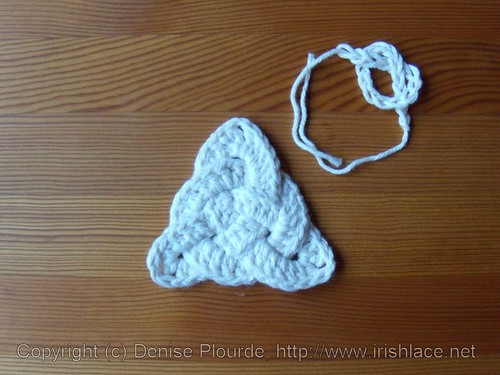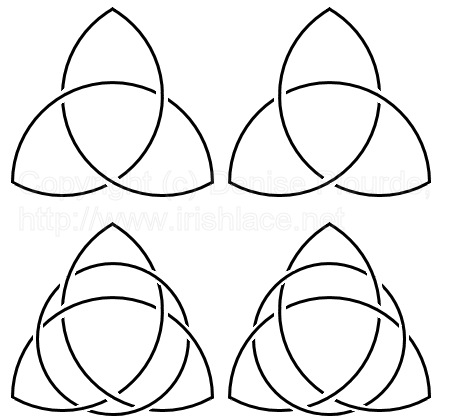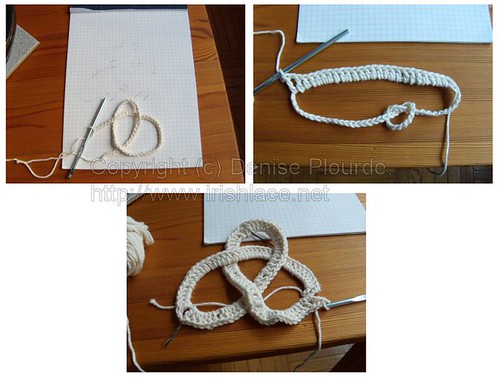
Knotty, but nice.
Materials
- Lily Sugar 'n Cream, 12 yds to make a knot 3.75" wide by 3.25" tall. (Or yarn you like.)
- Hook that gives you a fabric you like. The sample was made with a US H-8/5mm hook.
- Yarn needle for weaving in ends
- 2 stitch markers (open ring/safety pin type)
Instructions
In pictures
Since this has overlaps, I'm not sure how to do a chart. If anyone has any suggestions, let me know!The best I can offer are these diagrams of the triquetra:

In words
Abbreviations:
ch - chain
USdc - double crochet (US usage)/treble crochet (UK usage)
UStr - triple crochet (US usage)/double treble crochet (UK usage)
Trefoil
- Chain 36
- Mark the 12th and 24th chains.
- Tie a loose overhand knot in the chain.
- Join the chain into a loop (preferably without twisting)
- Chain 3 (counts as first USdc), 17 USdc in loop. This will bring you to the first stitch marker. Slide the stitches back a bit, then work UStr in loop before the stitch marker, ch1, then UStr in loop after the stitch marker, 18 USdc in loop. This will bring you to the second stitch marker, and you'll do the same thing: slide the stitches back, UStr-ch1-UStr.
- You may or may not have been chasing the overhand knot around the loop. You now will push the overhand knot onto the round of USdc. It's doable: loosen the knot and start pulling the USdc section through. When the knot is entirely on the USdc section, work 18dc, UStr, ch1, UStr, then join with a slip stitch in the top of the starting ch3. Break yarn, weave in ends.
- Loosen the overhand knot so that the you can form the band into the basic triquetra. The stitch markers flanked by UStr mark the points of the triangle, so keep those in sight.

Ring
- Chain 18
- Weave the ch18 strand into the triquetra along the path of the circle (see diagrams above to get a sense of the crossings), and join with a slip stitch in the starting chain.
- ch 3 (counts as first USdc), 26 USdc in ring. You'll need to move the chain through the triquetra to keep things going, and it's going to be fairly snug. Don't be surprised if it turns into a completely unidentifable cat-toy-looking thing. It'll work. Join with a slip stitch in the top of starting ch3. Break yarn, weave in ends.
- Tug on the circle to even the stitches out a bit and to get it to lie flat. (I'm a big believer in blocking, by the way, but there's some brute force tugging that needs to be done just to get the stitches into roughly the right area. They all want to bunch up at the end, for some reason, and it's not easy to redistribute them when the foundation chain is interwoven with something else.)
- Block as desired. (The sample had a very light blocking: one step up from "lay flat to dry".)
Enjoy!